Follow us on Telegram and on Instagram @humanresourcesonline for all the latest HR and manpower news from around the region!
share on
This comes in the face of ongoing talent challenges, whereby executives globally indicated widespread concerns about shortages of critical skills in the market and the high churn rate among employees.
With many changes being brought about in the working world over the past two years, navigating how you adapt may be a challenging feat.
Following the previous year's research which identified companies leading the way to create a more agile workforce (aptly referred to as 'the Vanguards'), KellyOCG's newest survey, Calibrating to power the life-work shift, took a closer look this time into how the Vanguards are leading on the life-work shift.
The new survey of 1,000 senior executives across 12 countries and 10 industries observed how leading businesses are recalibrating how they acquire the talent they need to win in today’s ultra-competitive markets.
Setting the context, the study noted that Vanguards were those employers who actually saw employee wellbeing and productivity increase during the pandemic, and reported higher revenue growth – an indication their approach was giving them a competitive edge.
In the 2022 research, the Vanguard groups were recreated using the same criteria to now make up 15% of the total sample, as compared to 11% of the total sample in 2021.
The study examined what these firms are getting right and what others can learn from their approach, given that these firms are far more likely to say that their ability to recruit talent has increased.
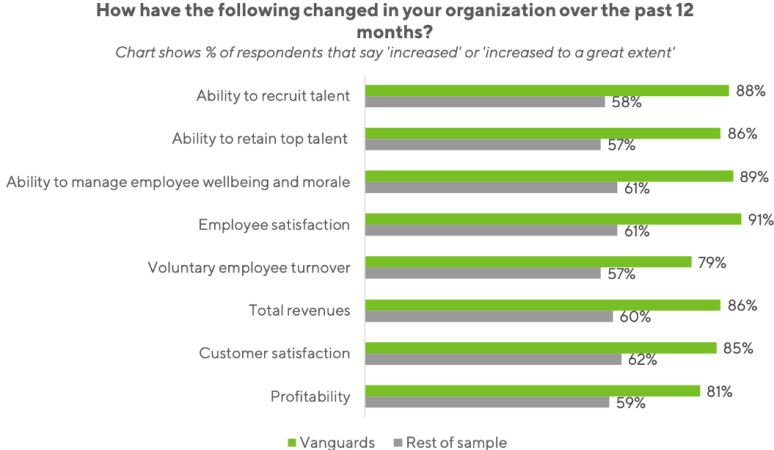
To gain a better understanding, the study identified four dynamics where the Vanguards are leading that will shape the future workforce.
Dynamic #1: Strengthening workforce agility
This raises the question: Do organisations have a comprehensive strategy for bridging skills gaps, from hiring new talent to bringing in contingent labour? Do they have the capabilities for rapidly meeting the business’s people requirements?
Dynamic #2 Reinventing the employee experience
Do businesses make it a priority to improve the employee experience? Do they benchmark their employee value proposition against those of competitors? Do they engage employees in reinventing work?
Dynamic #3: Taking concrete action on diversity, equity and inclusion (DEI)
Are company-wide DEI strategies in place to attract talent from underserved communities? Are these employees supported and offered training opportunities throughout their careers?
Dynamic #4: Adopting the right technologies to empower today’s workforce
Does the organisation make use of best-in-class tools for managing talent, boosting collaboration, and enhancing employee experience?
The first half of the study looked into understanding the post-pandemic talent challenge. Having noted in the previous year that a quarter of US workers planned on looking for a new job when the threat of the pandemic decreased, that intent has played out over the past year in employers’ experiences of the 'Great Resignation' — organisations are still grappling with an acute talent challenge in 2022.
When asked to identify the top talent challenges they face, executives indicated widespread concerns about shortages of critical skills in the market and the high churn rate among employees.
Yet the number one barrier to companies accessing the talent they need, alongside a lack of skills in the market, is a poor ability to hire contingent talent. Per the report, this indicates that businesses increasingly need to be able to rapidly recruit the skills they need on a non-permanent basis.
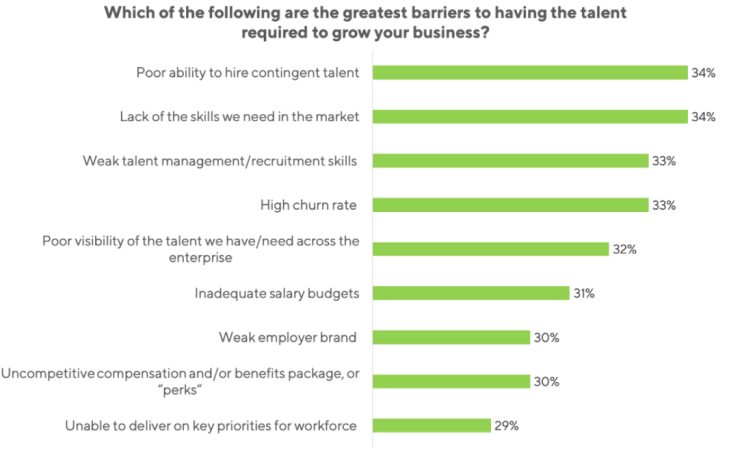
Another challenge identified was the rising employee expectations. For many employers, there is a growing sense that employee expectations have changed fundamentally since the pandemic – this view is held by 37% of the executives surveyed (and 42% of the Vanguards).
This is driving recognition of a need to redesign the employee experience within the next five years In fact, many organisations have already started. 38% of Vanguards are rethinking leadership skills, in comparison to the 23% of non-Vanguard firms. Meanwhile, 51% of Vanguards reported that leaders and employees are already re-inventing work together, to create a future that works for all (vs just 33% of non-Vanguards).
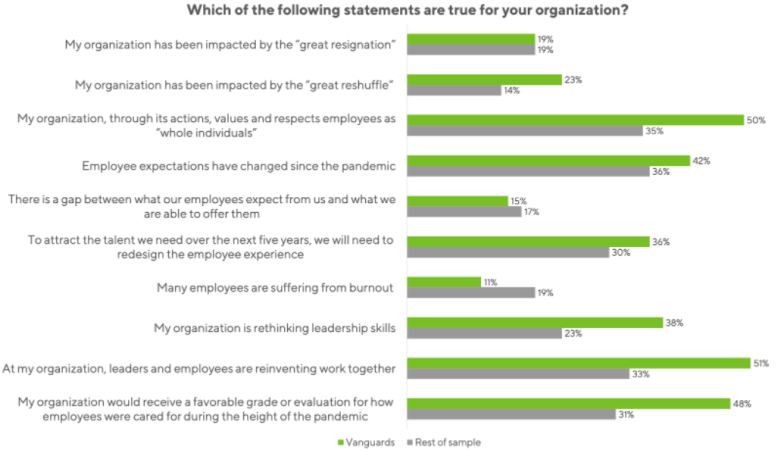
On the other hand, 61% of Vanguards’ executives say they are happy, compared with 38% among the rest. Further, 37% plan to stay at least two years (vs 27%), and only 5% are job hunting (vs 13%).
Mental wellbeing was another area of concern unearthed in the findings. In non-Vanguard companies, only 26% agree that their employer cares about their mental health, compared with 40% in Vanguard companies.
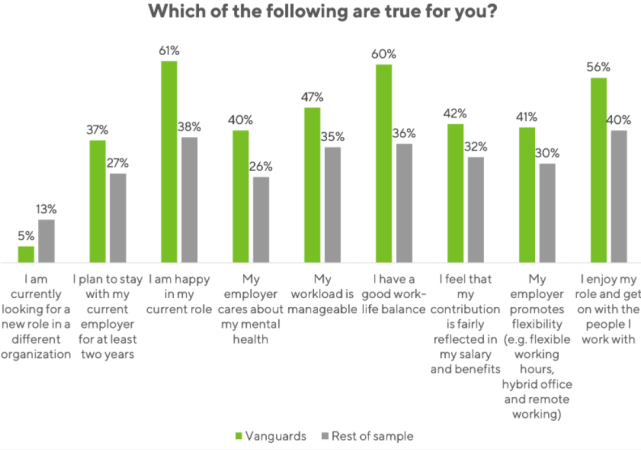
Exploring the possibility of hybrid working, it was noted that just 41% of executives in Vanguards and 30% in non-Vanguards say their organisation promotes flexible or hybrid options despite the changes brought about by the pandemic. Fewer than half have definitive plans for returning employees to the physical workplace (35%). About one in five are in favour of mandating a "hard return" (20%), though 28% think the complexity of hybrid will eventually drive a requirement for most employees to come back on-site.
While overall more view the impact of hybrid working as positive for organisational culture than negative, there are indications of unintended consequences: a significant number say that in-office employees are perceived as higher performers than remote/hybrid employees, and are more likely to be promoted. That risks creating division and undermining DEI efforts.
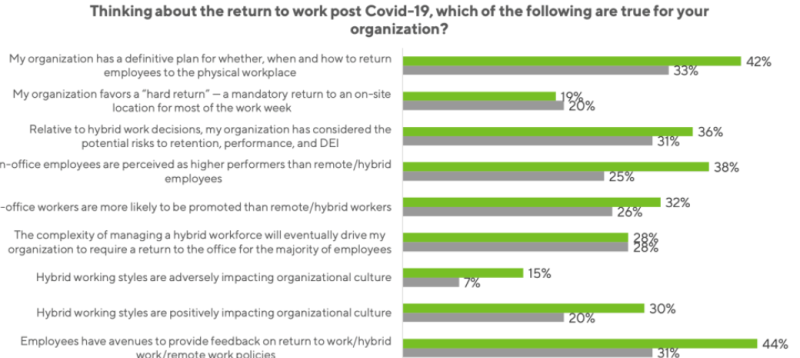
The second half of the report looked into the four dynamics and how organisations are calibrating to power the life-work shift.
Dynamic #1: Strengthening workforce agility
As touched on above, employers around the world face intense competition for talent. However, only a minority of firms are harnessing innovative approaches to improving workforce agility. Across the board, Vanguards are substantially more likely to have adopted these tools and tactics to improve their ability to work in new ways.
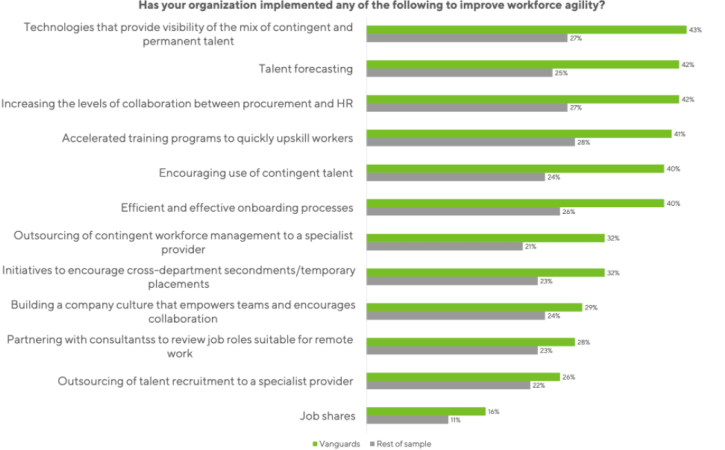
Dynamic #2: Reinventing the employee experience
Employers are continuing to face deep challenges in attracting and retaining talent, with fierce competition for roles at all levels of the market. While leaders say that a wide range of factors is contributing to the issues, they see the top causes as a lack of progression opportunities, uncompetitive pay and benefits, and poor life-work balance.
Vanguards have a particular advantage in using contingent talent. They are more likely to have a clear strategic approach, and they are more likely to forecast an increase in the use of contingent talent in the next five years.

KellyOCG also identified a lack of understanding among employees of the wider value of their work as a factor, which means that purpose is a vital tool.
For Vanguards, the response is to redefine/redesign the employee experience and experiment with new ways of working (83% for both, compared with 68% and 62% respectively among non-Vanguards). The data shows that, compared with other firms, Vanguards understand more acutely the importance of the employee experience in improving talent acquisition. This group is more likely to:
- Have started offering higher wages and better benefits (57% vs 38% of the rest)
- Provide better skills and development opportunities (66% vs 51%)
- Have improved the annual leave allowance (62% vs 45%)
- Have introduced policies such as salary transparency (54% vs 42%).
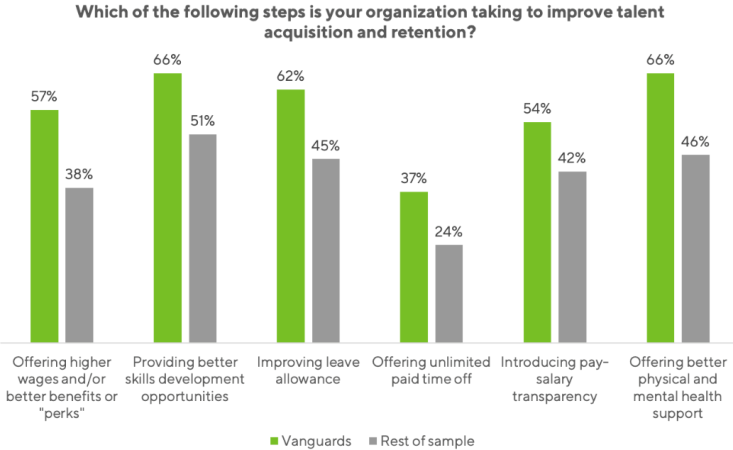
Interestingly, Vanguards admitted to being alert to their competition too, with 79% benchmarking compensation and benefits against competitors (vs 58%).
Vanguards also seem to benefit from the commitment of their senior leaders to reinventing employee experience — 57% say that at least one C-suite stakeholder has been very involved to date, which was almost double the rest (29%).
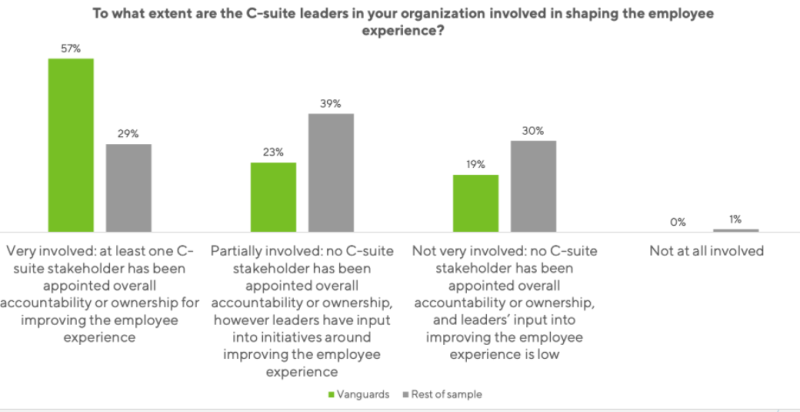
KellyOCG cautions that companies still face potential blind spots when it comes to understanding employee engagement, though. Less than half implement measures to assess employee engagement. Vanguards are more likely to use the tools available, from employee surveys and focus groups to assessing company reviews on Glassdoor.

Dynamic #3: Taking concrete action on diversity, equity and inclusion (DEI)
Research also shows that Vanguards continue to be differentiated by their efforts to make DEI a reality in their organisations. Despite the high profile of DEI issues in the past two years in the US and around the world, the survey reveals that only about a third of firms have implemented innovative initiatives to improve DEI.
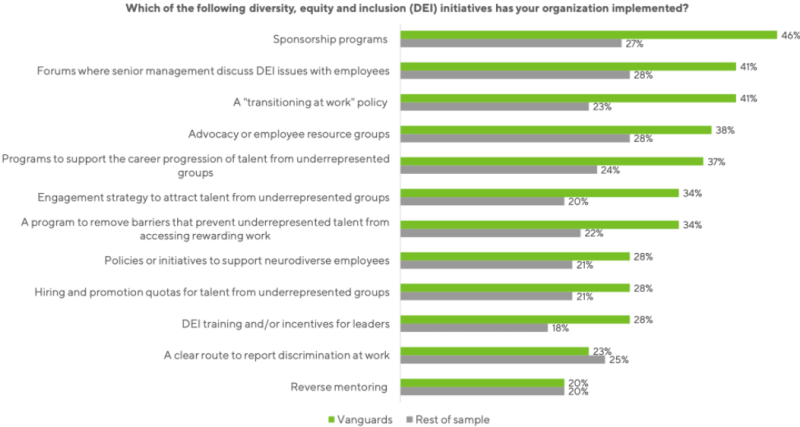
Over half of the executives (53%) say that leaders are failing to create an inclusive culture. Meanwhile a Vanguards, leaders are substantially more likely to regularly engage with employees on DEI. Despite so, many still recognise a need to go further, faster: Vanguards are more likely to agree that, in reality, their DEI strategy only pays lip service to the need to support underrepresented groups.
Looking into mental wellbeing support, the survey shows that many employers have taken action to support employees, but concerns still remain. Across all firms, 27% say that the number of employees who took time off or left their jobs for mental health reasons has increased over the past year. Further, less than a third say they have a workplace culture that makes it acceptable to disclose mental health issues (30%), while just 40% feel that their organisation offers adequate resources to support employees’ mental health.
Meanwhile, Vanguards are going further to promote mental wellbeing across the workforce: 47% of this group say they quickly address behaviours that would be considered bullying or discriminatory (vs 31% of the rest), while 41% say employees are entitled to paid leave for mental health reasons that have not been formally diagnosed (vs 27% of the rest).
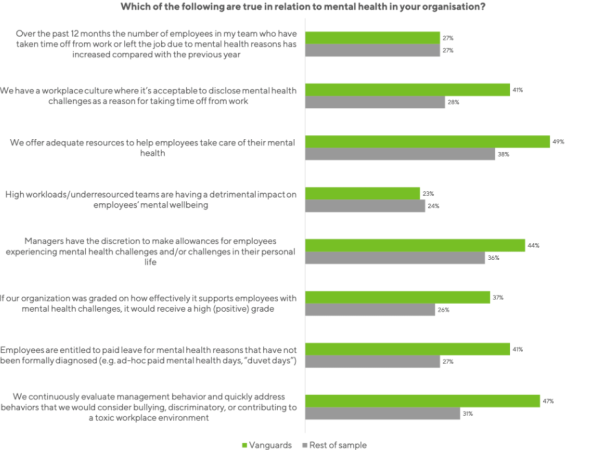
Dynamic #4: Adopting the right technologies to empower today’s workforce
With the current rapid rate of digitalisation, businesses have better options now more than ever for finding the right tools and technologies to power their talent management strategies.
Even with this shift, uptake is still limited. Just 40% of firms overall have adopted data analytics tools that capture key metrics, for instance. There is a huge opportunity to accelerate the digitalisation of HR and talent processes to gain advantage.
The Vanguards understand the importance of technology adoption in improving workforce agility and productivity. Research shows they are more likely to have adopted all of the relevant technologies, including data analytics, knowledge sharing and pulse survey tools; as well as dedicated training platforms.
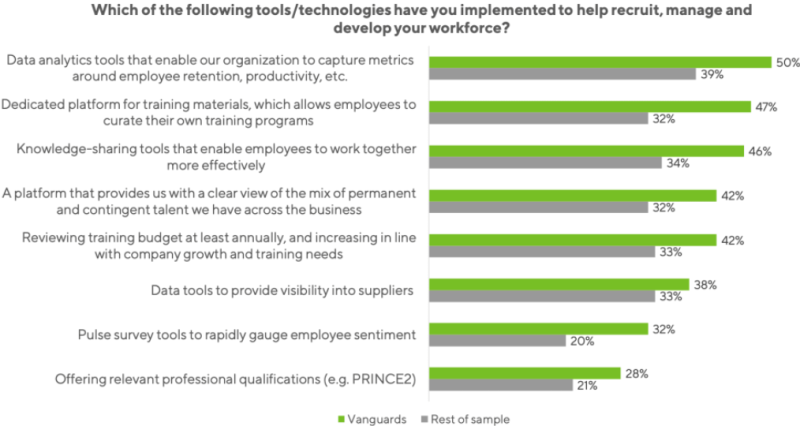
In the era of hybrid working, another key dimension for technology is its potential for monitoring employee productivity. Generally, survey shows productivity tracking tools have generally been positively received by employees – especially in Vanguard firms.
All images / KellyOCG
share on


